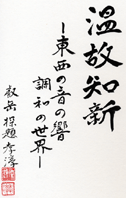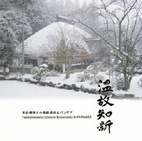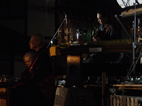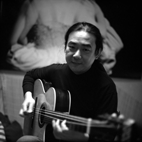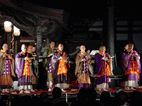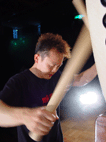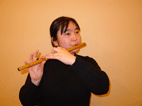|
天台聲明音律研究会代表 深大寺貫主 谷 玄昭
聲明<しょうみょう>は、古代インドでバラモン僧が習得すべき五つの実践的学問である「五明」の一つでした。聲明(言語学)、因明(論理学)、内明(心理学)、医方明(医学・薬学)、工巧明(造形学)の中で、広く音韻学とも呼べる音声言語に関する学問を指す言葉でした。
インドから中国を経て日本に伝来した仏教の儀礼音楽は「梵唄」<ぼんばい>ど呼ばれていましたが、平安時代末期に「声明」の意味が変化し、発声や音の抑揚など音楽的な内容だけを指すようになり、仏教の儀式や法要で僧が唱える声楽を呼ぶようになりました。
日本で聲明が盛大に行われた最初の記録は、天平勝宝四年(七五二)東大寺の十一面観音悔過法会と大仏開眼供養です。現在、声明の系統は奈良の南都仏教、平安の天台・真言密教、鎌倉以降の仏教と大きく三つに分けられます。
天台声明は、最澄の高弟・円仁(慈覚大師)が唐の五台山などで聲明を学び八四七年に帰国、比叡山延暦寺で天台声明を確立、以来千百五十年間、確固とした理論のもとに正しく伝承され、その格調の高さは我が国声明中最右翼といわれます。
本山の根本中堂からの声明は全国に広がり、中世以降の日本の音楽に大きな影響をあたえました。中世の平曲と謡曲の旋律構成は声明と同類で、浄瑠璃も平曲を通じて間接的に影響を受け、各地の民謡にも聲明が大きな影響を与えました。
Tendai Syomyo Chants
Gensho Tani Representative of Tendai Chants Research
Society,
Head Priest of Jindaiji Temple
Syomyo was one of the five myo, or practical studies, that
brahmana (brahmin) had to master in ancient India. Shomyo,
the study of phonemes, was studied together with Inmyo
(logic), Naimyo (Psychology), Ihomyo (Medical Science and
Pharmacology), and Kugyomyo (Arts and Mathematics).
Buddhist ceremonial music was transmitted to Japan through
China and was called Bonbai. However in the late Heian
period, the meaning of Syomyo changed and came to mean only
musical matters concerning the vocalization and risindg and
falling of tones. Finally, Syomyo became the vocal music
that was chanted by Buddhist priests at Buddhist
ceremonies.
According to historical recoeds, in the year Tenpyo-shoho 4
(752 AD), the first large scale Shomyo chants ware presented
at Todaiji Temple in Nara on the occasion of the Juichimen
Kannon Keka Hoe (the repentance ceremony of Eleven-faced
Kannon) and the Daibutsu Kaigan Hoe (the ceremony of the
opening of the eyes of the Giant Buddha Image). The present
day linage of Syomyo chants is classified into three large
streams,the Nanto Buddhist traditions in the Nara period,
the Tendai and Shingon Buddhist traditions in the heian
period, and other traditions after the Kamakura era.
Jikaku Daishi Ennin, a leading disciple of Saicho, studied
Syomyo on Mt. Wutai and other places in Chaina. In 847 he
came back to Japan and estblished the Tendai Shomyo
tradition at Enryakuji Temple on Mt. Hiei. For 1,150 years,
it has been strictly passed down from master to disciple
through established theory. Tendai Syomyo is known at the
most sonorous style of chant.
The Syomyo that was chanted in the Main Hall of Tendai
Headquarters spread all over Japan and heavily influenced
Japanese music after medieval times. The Heikyoku and
Yokyoku systems of melody were somewhat similar and through
Heikyoku, Joruri was also affected by Shomyo and Syomyo also
had a influence on regional folk songs.
|
|
光明供錫杖について
密教の「光明供」を導師(修法者)<しゅほうしゃ>が修している間に、式衆が「九條錫杖(聲明曲)」を読誦<どくじゅ>しながら錫杖を振る法儀で、主に施餓鬼会法要<せがきえほうよう>や葬儀式に使用される。光明供とは光明真言法のことで、毘廬遮那如来<びるしゃなにょらい>(大日如来)、或いは無量寿如来(阿弥陀如来)を本尊とし、滅罪、息災、除病、亡者<もうじゃ>への追善のために修する秘法で、行者(修法者)は伝法を受けて修する。光明真言には無量の福徳があり、これを誦<じゅ>すれば仏の光明を得て、六根の罪障を除き、七難の災厄を払うとされる。
「錫杖」とは比丘十八物<びくじゅうはちもつ>の一つで、僧が遊行するとき携帯する道具である。野山を巡行するとき、毒蛇や毒虫などの害から逃れるため、これを揺すって音を立てて歩くとされる。
「九條錫杖」とは華厳経浄行品<けごんぎょうじょうぎょうほん>にその一部の偈文<げもん>が見られるが、他に出典は見あたらない。錫杖の功徳<くどく>が説かれ、曲中の一定の個所で錫杖が振られる。錫杖を振る音に特別な呪力<じゅりき>があるとされ、その力による衆生の解脱菩提<げだつぼだい>を願って唱えられる。
"KOMYOKU-SYAKUJO"
"KOMYOKU-SYAKUJO" is one of esoteric Buddhism ceremony.
In this ceremony, while DOSHI (a leader of monks) is holding
"KOMYOKU" service, other monks shake SYAKUJO chanting
"KUJOSYAKUJO" (sutra). It's often done at a Buddhismt
memorial service or a funeral service.
"KOMYOKU" is "KOMYOSHINGON" dharuma. We pray to
BIRUSYANA-NYORAI (DAINICHI-NYORAI) or MURYOJU-NYORAI
(AMIDA-NYORAI). We hold the service for extinction of sin,
driving away disaster, getting rid of illness and praying
for the repose of one's soul. It's a secret process. Monks
can do it after recieved the instinction of it. It's said
that "KOMYOSHINNGON" has a power of infinite blessing and if
it's chanted we can get the light of Buddha, we can extinct
sin of 6 kinds of sense (vijnara), we can drive away 7 kinds
of disasters.
"SYAKUJO" is one of BIKUJUHACHIMOTSU (18 goods of a trainee
monks, Monks take these goods when they do esoteric
practices.). It's said monks walk shaking SYAKUJO and making
sounds to avoid a poisonous snakes and poisonous insencts
when they walk around mountains.
"KUJOSYAKUJO" (sutra) is found in "KEGONKYOJOGYOHON"(sutra).
It's not found in other sutras. In "KUJOSYAKUJO" (sutra),
the divine grace of SYAKUJO is preached and in this service
SHAKYJO is shaked at some places by monks. It's said the
sound of shaking SYAKUJO has a special power. And it's
chanted to pray for salvation from the bondage of this world
and the Supreme Enlightenment of the world by its power.
|
